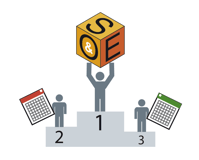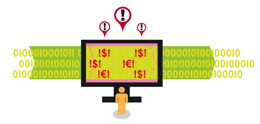How to Make Planning and Execution Work Together
Brian Hoey - February 22, 2018

 Imagine for a moment that you’re on a flight from London to New York. You probably take It for granted that someone has charted an appropriate route at an appropriate altitude based on weather and air traffic patterns, and that departure, arrival, and flight time have all been carefully calculated based on past flights and current conditions. At the same time, no matter how much planning has gone into a flight, you probably also take it for granted that there is a pilot in the cockpit, measuring real-time information with her instruments and communicating with air traffic control to make necessary adjustments and course corrections as new scenarios emerge.
Imagine for a moment that you’re on a flight from London to New York. You probably take It for granted that someone has charted an appropriate route at an appropriate altitude based on weather and air traffic patterns, and that departure, arrival, and flight time have all been carefully calculated based on past flights and current conditions. At the same time, no matter how much planning has gone into a flight, you probably also take it for granted that there is a pilot in the cockpit, measuring real-time information with her instruments and communicating with air traffic control to make necessary adjustments and course corrections as new scenarios emerge.
If either one of these elements were lacking, passengers would be rightly concerned for their safety, to say nothing of their connections and transportation arrangements. When they’re both in place, however, they represent an instructive example of how planning and execution can and should work together to more consistently reach business goals. Much like flight planning, sales & operations planning (S&OP) is a necessary logistical guidepost that requires a separate but equally important function (sales & operations execution (S&OE), the metaphorical pilot) in order to keep things running smoothly and avoid unnecessary disruptions.
Separation
It may seem somewhat paradoxical, but the key to ensuring that S&OP and S&OE work together is to keep them separate. Without clearly defined roles established for both planning and execution, there is a strong likelihood of wasted effort and operational confusion as planning operations meddle in the work of day-to-day and week-to-week execution. If a given business has an S&OP cycle of three months, for instance, all planning matters that pertain to the next zero to three months (this will most likely included transport logistics, job shop or other production scheduling, inventory management, and other short-term tasks that are repeated frequently throughout the year) should be the exclusive purview of S&OE.
By separating these two functions in this way, each one is free to optimize its own unique processes within clearly defined parameters, ensuring that there is a minimum of redundant work. Sales and operations planners can focus on actual planning, instead of the daily and weekly supply chain disruptions that they're not especially well-equipped to handle. Knowing that their mid-term plans are being supported and stabilized by S&OE, planners can take a future-oriented approach to setting goals, developing stratagems, and defining key performance indicators (KPIs). Rather than being locked in a reactive cycle of supply chain risk management, S&OP can take a more holistic view of their operations and the entire global supply chain to develop bold new initiatives that integrate more fully into their organization’s long-term strategic planning.
For its part, S&OE can focus on monitoring real time demand and supply fluctuations as its sole business function. It can smooth out short-term supply chain events by dynamically scheduling transport and restock orders, while bolstering S&OP efforts by acting as an early warning system for potential larger-scale bottlenecks and breakdowns looming in the mid- to long-term.
Integration
Once planning and execution are effectively separated out into mutually-supportive, well-defined roles, it’s possible to further optimize this operational feedback loop by more carefully integrating their processes. S&OP and S&OE should remain distinct and independent, but building a more synergistic relationship between them can be a meaningful value added proposition. For example, S&OP cycles can drive an intra-operational boost in data collection and quality, so that the execution team can even further reduce the need to reschedule production, expedite raw materials, and use outbound priority transportation in response to disruptions and delays.
An increase in data quality and aggregation, in addition to yielding more effective demand tracking and increasingly agile and dynamic short-term supply chain management, can further integrate planning and execution by paving the way for the adoption of advanced analytics. Analytics can ultimately add value for both S&OE and S&OP by offering a number of smart workflow improvements:
- Improved demand forecasts will aid mid-term planning efforts while reducing daily and weekly deviations on the execution side.
- “Digital twins” and hypothetical “What-if” models can offer new insights into proposed changes in production processes or value streams.
- Real-time data and increased visibility can yield holistic insights into potential supply chain improvements.
- Processes like restocking orders and scheduling maintenance can be partially or fully automated, saving person-hours and money.
Sales operations software solutions can be a useful driver of this level of analytics integration, but whatever route you take towards integrating planning and execution, they stand to work together as mutually-additive value propositions. Just like with our transatlantic flight, these distinct processes can help minimize turbulence and increase on-time performance.
LATEST POSTS
- Understand Circular Economy in The Manufacturing Industry
- How Can Industry 4.0 IT Integration Be Achieved Smoothly?
- The Significance of Order Sequencing in Discrete Manufacturing
- How to improve your Supply Chain Management: The Power of Control Towers
- Optimizing Human Resource Scheduling in Manufacturing: A Technological Approach



